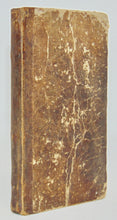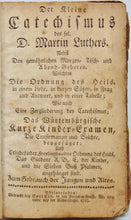Luther, Martin. Der kleine Catechismus des sel. D. Martin Luthers; Nebst den gewöhnlichen Morgen- Tisch- und Abend-Geb̈ten. Welchem die Ordnung des Heils, in einem Liede, in kurzen Sätzen, in Frag und Antwort, und in einer Tabelle; wie auch eine Zergliederung des Catechismus; das Würtembürgische kurze Kinder-Examen, die Confirmation und Beichte, beygefüget; und etliche Lieder, Freylinghausens Ordnung des Heils, das güldene A, B, C, der Kinder, und die sieben Buss-Psalmen, angehänget sind. Zum Gebrauch der Jungen und Alten. Philadelphia: Carl Cist, in der Zweyten-Strasse, no. 104, nahe bey der Rehs-Strasse, 1795. [8653]
Calf spine, plain paper over card, 14 cm (5 1/2 x 4 1/4 inches), [4] + 127 + [1] pp. Binding rubbed and worn with some loss to the corners; contents browned with occasional stains; front free endpaper with an early ink inscription in German, dated March 16, 1798. Good. Hardcover.
Evans 28993. An early printing of the Pennsylvania Ministerium catechism adapted for the use of children.
The publisher, Charles Cist (1738-1805), born Charles Thiel in St. Petersburg, Russia; he graduated from Martin Luther University of Halle-Wittenberg with a medical degree. He emigrated to the American colonies in 1769 at which time he changed his name. In 1773 he settled in Philadelphia and learned the printing trade. He was a prominent Philadelphia printer of the colonial and post-colonial era, issuing works in both German and English. An active supporter of the revolution (he had published Thomas Paine’s The American Crisis), he fled Philadelphia when the British took the city in 1777. He started the American Herald in 1784 and the Columbian Magazine in 1786. During the administration of John Adams he became the public printer and established a printing and binding firm in Washington, D.C.
Along with the printing business he was the first person to introduce anthracite coal to the United States, facing opposition in Philadelphia where the public thought he was trying to sell blackened stones. He also was secretary (1793) of the Fame Fire Association which introduced an apparatus for escaping burning buildings.







